The Value That Heat Exchangers Bring to the Beverage Production Process
Sign Up for Maintenance Tips
Posted on Sep 27, 2022 9:00:00 AM by AGC Heat Transfer | 7 min. read
Nearly every beverage on today’s shelves was created with the help of a heat exchanger. So what do heat exchangers do to help make safe beverages? Let’s dive right into the role that plate heat exchangers play in the beverage production process.
What Beverages Can Be Tempered Using a Plate Heat Exchanger?
Virtually any beverages you need to temper are compatible with a plate heat exchanger. AGC products are commonly used to produce:
-
Fruit juice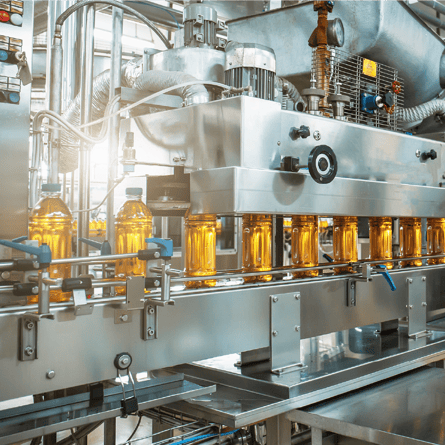
- Liquor
- Soft drinks
- Sports drinks
- Tea
- Syrup
Even beverage products containing carbonation and pulp can be tempered with a plate heat exchanger. In fact, fruit juice pasteurization is one of the more common uses of a plate heat exchanger within the beverage industry. That’s because the large heat exchange surface area leads to a quick and consistent heating and cooling process, which is great for pasteurizing beverages.
Beverage Heat Exchange Process
Simply put, plate heat exchangers are used to heat and cool beverages during production. But let’s take a closer look at how a heat exchanger works to produce different types of beverages (and how this process varies between beverage types).
Beer and Cider
Plate heat exchangers are used in nearly every brewery, regardless of size, to raise and lower the temperature of wort and beer.
As part of the brewing process, malted barley is steeped in hot water. Once this mixture turns into wort, it is boiled in a kettle and immediately cooled. Because the wort needs to be cooled to around 53°F as fast as possible to deactivate dimethyl sulfide (DMS) and preserve the beer’s flavor, it’s crucial to have the right equipment (e.g., a heat exchanger) to bring the temperature down. This becomes increasingly more difficult with higher volumes of beer. Smaller breweries might add ice to their kettle, put the kettle in ice, or use a wort chiller to complete this step.
Once the beer is cooled, it undergoes fermentation. The water used to cool the beer is often reused to make wort.
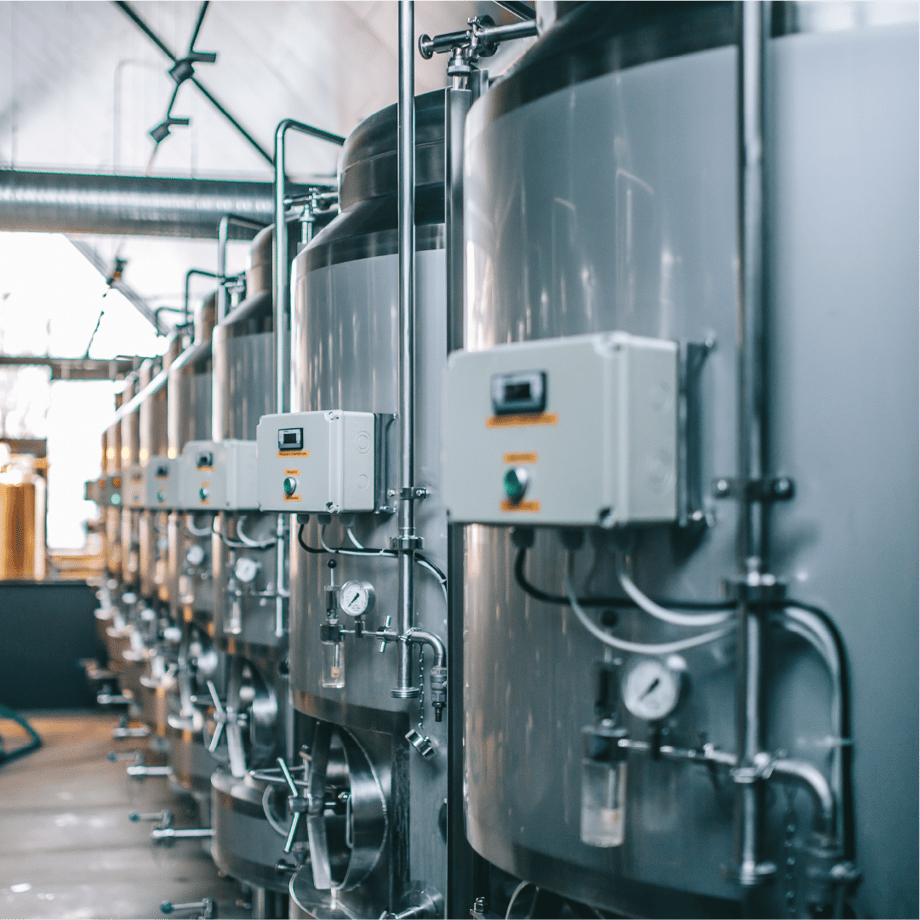
Wine
Temperature control is pivotal for the wine production process. After grapes are harvested, prepared, fermented, aged, and blended, a plate heat exchanger is used for the wine’s fermentation process. During this process, yeast turns the natural sugars of the grapes into alcohol. For proper fermentation, the wine must be warmed to around 67ºF for white wine and 77ºF for red wine.
Following the wine fermentation process, the heat exchanger is used to lower the temperature of the wine to around 27ºF, which stops the yeast reaction (and the fermentation process). After 24 hours at this cooler temperature, the wine can head toward the bottling process.
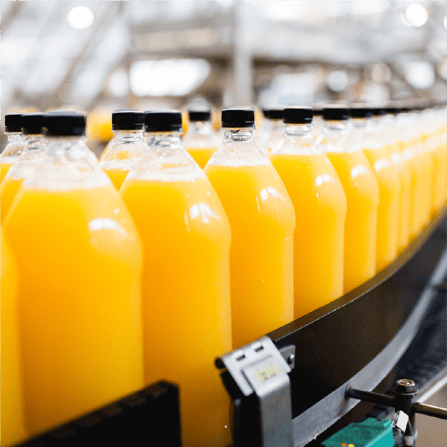
Soft Drinks/Sports Drinks
To create soft drinks and sports drinks, syrup runs through the heat exchanger and is heated to over 200ºF. This process occurs before carbonation is added to the product. With the precise heating and cooling allowed with a plate heat exchanger, the equipment helps ensure the taste and color of the product remains consistent and helps prolong shelf life.
Juice (Pulp and No Pulp)
Similar to pasteurization for dairy, plate heat exchangers are used to kill harmful bacteria in juices. But unlike dairy plants, the juice production process must account for pulp and acidity (and the fouling and corrosion that can occur faster as a result). During its pasteurization process, juice is heated to around 205ºF for a designated amount of time.
Beverage Pasteurization Process
Plate heat exchangers are responsible for pasteurizing beverages before they are cooled, stored, and eventually consumed. Not only does this process improve beverage flavor and taste, but it also helps ensure that products contain a safe level of bacteria. The pasteurization process for beverages is similar to that used in dairy plants.
Typically, there are two main beverage pasteurization methods: standard and flash.
Standard Beverage Pasteurization
Many beverages undergo pasteurization to ensure they are safe for consumption. Pasteurization also extends the shelf life of many carbonated beverages by preventing microbes from fermenting and degrading the product.
Flash Beverage/High-Temperature Short-Time Pasteurization
Flash beverage pasteurization, or high-temperature short-time (HTST) pasteurization, is used both in the dairy industry and the beverage industry. This process heats the liquid quickly (usually for 15–30 seconds at around 160–165ºF) to kill certain types of bacteria before cooling the liquid back down to around 40º–42ºF. This process helps keep beverages like fruit juices, ciders, and beers from degrading.
Common Heat Exchanger Challenges in Beverage Plants
Fouling — Fouling refers to build-up on the heat exchanger’s plates. Depending on the beverage being produced, this could be particulates from fruit juices or a build-up of syrup used to make soda. Fouling is normal and expected, but it eventually requires a plant to take action to ensure a safe, high-quality product.
To address fouling, plants must complete clean-in-place (CIP) measures at the necessary interval.
Corrosion — Beverages like sodas contain acid, concentrates, and syrups, while sports drinks contain salt. These ingredients can lead to corrosion. As a result, standard stainless steel plates do not withstand the beverage production process as well as they might in a dairy plant. Therefore, beverage plants often use plates made with Hastelloy, which makes them more resilient against corrosive media and prolongs the plate’s lifespan.
Improper maintenance — Without proper maintenance measures in place, harmful bacteria can make their way into a product. Ensuring that plate gaskets are regularly replaced and plate surfaces are sufficiently cleaned and inspected helps plants produce safe, quality products.
Unplanned downtime — When equipment is not maintained correctly (or doesn’t receive proper CIP or inspections), it can quickly lead to expensive repairs and unplanned downtime. This impacts a plant’s bottom line and leads to undue stress.
Plate Heat Exchangers vs. Shell and Tube Heat Exchangers
Plate heat exchangers offer several unique advantages compared to shell and tube heat exchangers, including:
- Scalability — As your production volume grows, your high-value equipment should be able to grow with you. Plate heat exchangers are often built with extra room within the frame. Start with the number of plates you require today, with the option to add more plates in the future.
- Easier maintenance — Plate heat exchangers can be opened for inspections and maintenance. You can also easily replace a damaged plate. While both are cleaned using a CIP process, a plate in a plate heat exchanger can be removed for more extensive cleaning when fouling creates an excessive build-up within the equipment.
Shell and tube options are more challenging to clean, as liquids flow through an enclosed space that cannot be easily opened and inspected. They are also more expensive to fix, as replacing a single part isn’t always possible, and a fix might require the plant to replace the entire unit.
- Efficiency — Beverage plants are known for having high production volumes. Low-pressure losses and high sanitation standards mean lower operating costs for your company. And variable pressing depths and a large heat exchange surface area deliver efficient thermal performance, and closely controlled heating and cooling.
Heat Exchanger Sizing
The size of your heat exchanger depends on your plant, including your unique process, ingredient mix, and production volume. It’s also smart to consider your growth goals to ensure your heat exchanger can scale as you increase your production volume.
When you invest in a larger frame, you can add plates down the road to accommodate more volume as you grow. At AGC, we custom-build heat exchangers to fit within your plant’s footprint while also considering future capacity.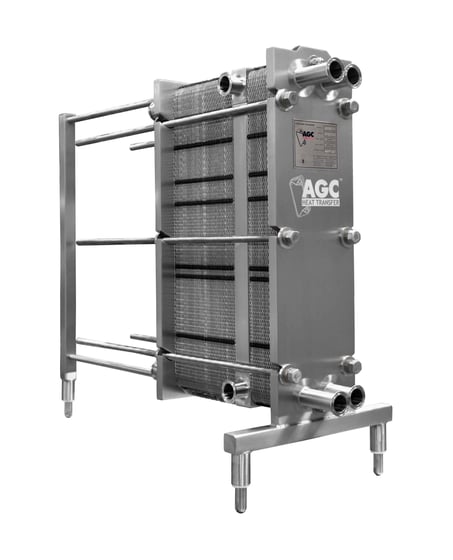
Equipment Designed With Beverages in Mind
We designed our plates for the food and beverage industries, which leads to:
- Reduced fouling from beverage particulates during the heat exchange process
- A more effective CIP process
- A more efficient thermal transfer
Plus, our hydraulic frame options make it easy to open large equipment for plants producing a high volume of product.
We Design Our Equipment for Your Product
With our free rheology test, you can overnight a sample of your product to our facility. Once we receive your sample, we can test it to make sure that we create the most efficient, effective design to produce your product. This is a quick, easy, and free way to make sure that you are getting the best design for your process.
The Importance of Double Wall Plates in the Beverage Industry
Double wall plates are designed to have two identical plates stacked on top of each other with a thin layer of air between them. This prevents the media from contaminating the product in the event of a leak.
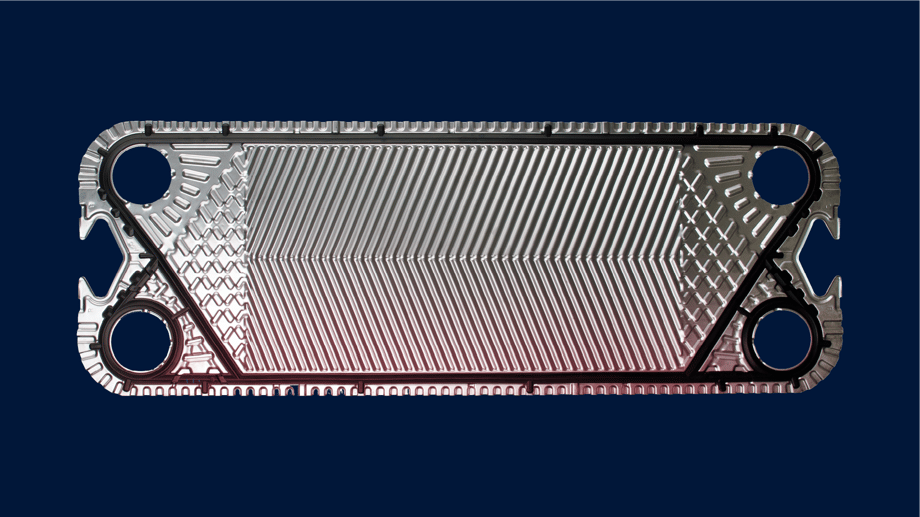
AGC Leads in Heat Exchanger Lead Times
Today’s global supply chain has made beverage production all the more challenging. At AGC, we plan ahead and understand what our customers will need. As a result, we are the leading supplier of sanitary plate heat exchangers in North America.
AGC can often custom-build a heat exchanger in 6–12 weeks. We also have spares in stock for both AGC equipment and a wide range of OEM brands and models, and we have the stock on hand to expedite plate packs and gasket orders for your plant.
Serving Large and Small Beverage Producers
Whether your company outranks the competition in volume, or you are starting up your own microbrewery, we have a heat exchanger that will work for what you need.
Building the Best, Servicing the Rest
You rely on hyper-accurate and sanitary temperature control for tasks like juice pasteurization and liquor distillation. Plate heat exchangers are your all-purpose solution for these needs.
AGC is unique because we custom-build our equipment while also servicing most brands and models in the beverage industry. Our heat exchangers are built right here in the United States — and with the addition of our new Midwest service center, we can serve plants across the nation more quickly than ever before.
Topics: Heat Transfer Plates



